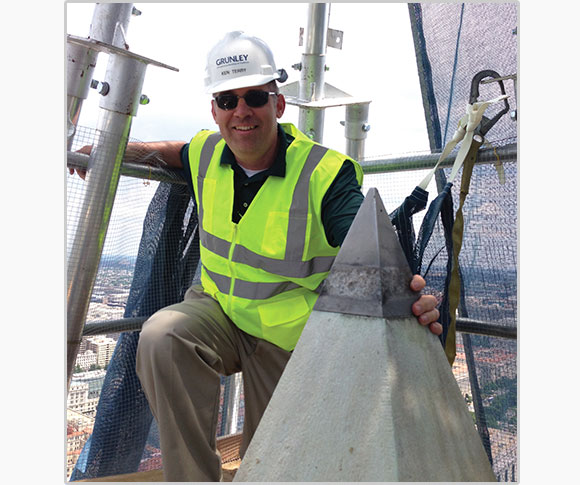ALUMNUS PROFILE

Washington, D.C., is one of the most recognizable cities in the world, its skyline, monuments, memorials, and buildings featured in countless movies, television shows, and photos. In particular, the city's monuments define the events and people that have shaped the United States.
Kenneth Terry (civil engineering '94, MBA '14) would know. As lead project manager for the National World War II Memorial, lead engineer on the Martin Luther King Jr. Memorial, and, most recently, project executive leading repairs on the Washington Monument, Terry has left his imprint on the landmarks of the nation's capital.
Terry's first assignment after graduating from Virginia Tech was the Ronald Reagan Building and International Trade Center. As a project engineer with Tompkins Builders, he spent two-and-a-half years coordinating the fabrication and installation of huge stones that form the exterior façade of the building. "I gained a lot of experience on that project in terms of new stone fabrication and installation," Terry said. "I was just lucky to be on the project, and I learned a lot. Then about eight years later, the World War II memorial came around, and I already had an unusual amount of experience with new stone construction."
In June 2001, under a joint venture between Tompkins and Grunley-Walsh, Terry became the project manager for that memorial, which remembers the 16 million who served in the U.S. armed forces, the more than 400,000 who died, and those back home who supported the war effort. The memorial holds special meaning for Terry. "Both of my grandfathers were in the military, and they were in the war. And, of course, everyone was touched by the conflict," said Terry. "I worked on that project every day for three years. Each project I've worked on has its interesting stories and memories, but the World War II Memorial was the most rewarding and the one I had the most personal connection with."
Barry Owenby, assigned by the American Battle Monuments Commission as the memorial's project executive, worked alongside Terry. "Ken was very proactive in problem avoidance. And when an issue came up, he focused on fixing the problem, not fixing the blame," Owenby said. "Ken is a man of integrity. He also has a very effective manner in dealing with clients, subordinates, and his leadership. He has a tremendous reservoir of professional experience and knowledge."
In 2007, Terry was asked by the Martin Luther King Jr. Memorial Foundation to serve as the project executive on a memorial to commemorate the civil rights leader. The design for the memorial—the first on the National Mall dedicated to an African American—was selected through a competition administered by Virginia Tech's Washington-Alexandria Architecture Center. (Read the story from the winter 2012-13 edition.)
Most recently, Terry, now with Grunley Construction, led the restoration of the Washington Monument, which was damaged when a 5.8-magnitude earthquake hit Virginia on Aug. 23, 2011. "Initially after the earthquake happened, the U.S. National Park Service had what they call their 'special access team' assess the damage," said Terry. "They rapelled down the four faces of the monument over a period of four to five days with cameras and photographed every instance of damage."
From there, the team created a set of designs to guide the repairs. "Once we arrived at the site, we erected the scaffolding, which took about three months, and once that was in place, we could more easily inspect the areas," said Terry. The restoration project lasted from November 2012 to May 2014.
Terry wasn't the only Hokie working on some of the most visible and important structures in the country. "On each of these projects, there was a significant number of people from Virginia Tech involved," Terry said. "On the World War II memorial, the contracting officer was an alum, and one of the designers went to the architecture school. On the Washington Monument repair, one of the engineers had just graduated. And there are plenty of people from the National Park Service who are alumni as well. One of the neat things about working in D.C. is that you run into a lot of people [from Virginia Tech]."
Besides his specialty in memorials, Terry also helped restore St. Elizabeth's Hospital, a mental health facility in D.C., from 2006-09. "Building buildings is very different than building or restoring memorials," he said. "The attention that the memorials draw makes them complex because there are so many people [involved at] every step of the way. Politically, building memorials is more challenging, but from a technical standpoint, building buildings is more challenging."
Terry said his time as an undergraduate provided him with a base of engineering and construction knowledge. "I also learned the importance of working within a team to accomplish a project, relying on every members' ideas and strengths to solve problems and achieve the common objective," Terry said.
Andree Yaap, a project executive for Grunley's interiors department, works with Terry, who as a deputy operations manager supports the department's human resources needs. "Ken has excellent people skills," Yaap said. "He is dependable, friendly, hardworking, and a great team player. If I had to pick his greatest strength, I would say it is his problem-solving and planning skills."
In May 2014, Terry completed his MBA at Virginia Tech's Northern Virginia Center in Falls Church, Virginia. "[The MBA] helped me to fill a lot of gaps in my knowledge of how to manage the business side of the construction industry," he said. "I learned a lot from my professors and fellow students about topics which I intuitively figured out through my years of working experience, but never fully understood."
What's next for Terry? Two projects are quite prominent—at the Smithsonian's National Museum of American History and the National Museum of Natural History. He's also completing two D.C. apartment buildings—perhaps the least recognizable projects in the portfolio of America's monument builder.